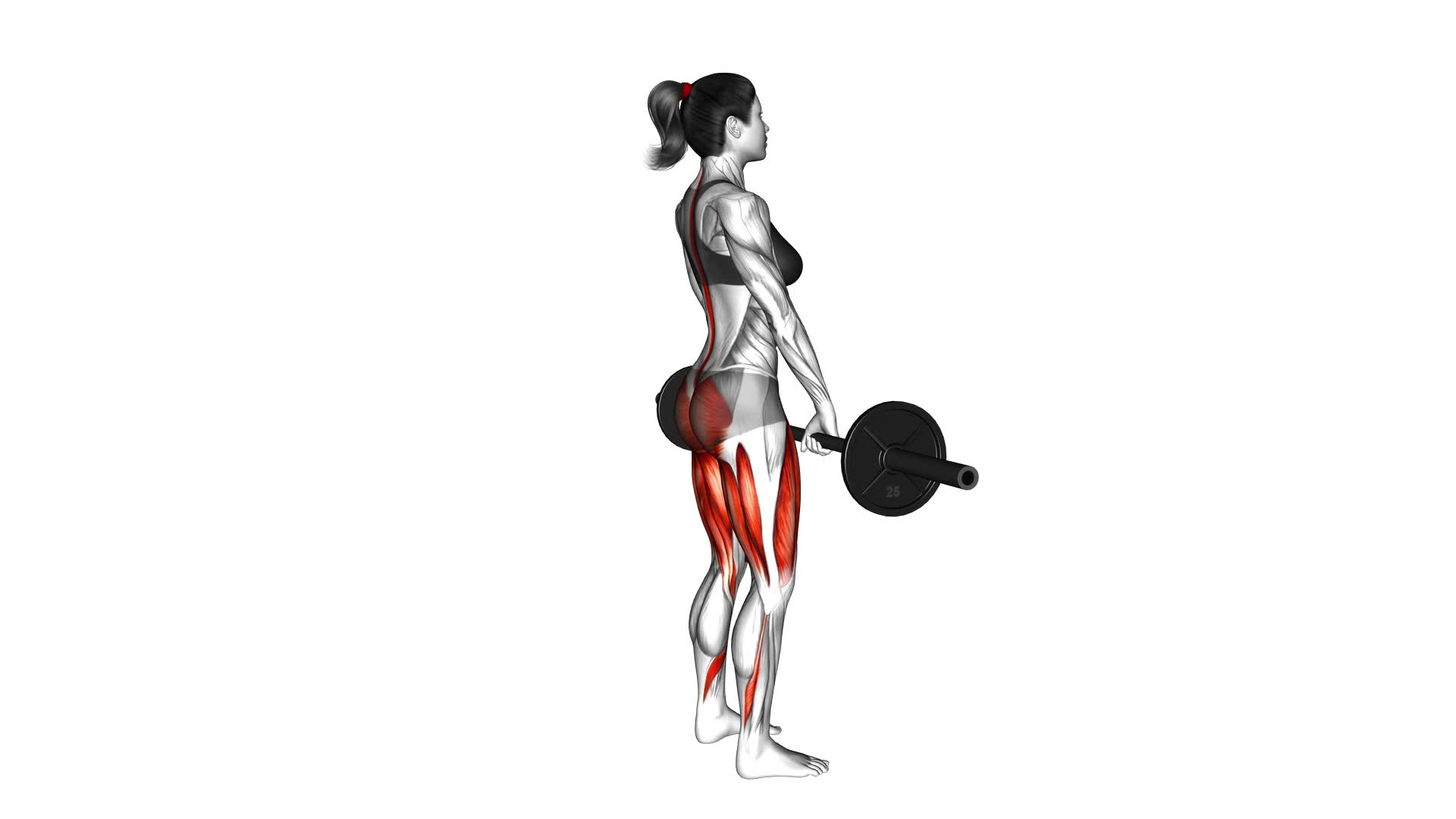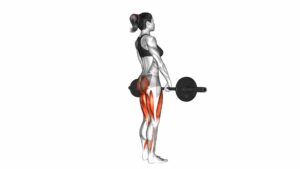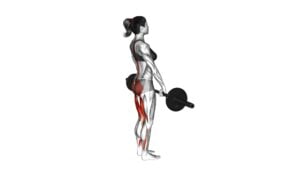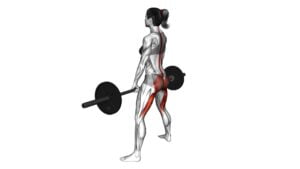Barbell Deadlift (female) – Video Exercise Guide & Tips

Are you looking to improve your strength and overall fitness?
Watch This Exercise Video
The barbell deadlift is a fantastic exercise for women that targets multiple muscle groups at once.
In this video exercise guide, you'll learn the proper form and technique to maximize your results.
We'll also cover common mistakes to avoid and provide tips for progressing and increasing weight safely.
Get ready to take your workouts to the next level with the barbell deadlift!
Key Takeaways
- Barbell Deadlift strengthens the entire body and engages multiple muscle groups simultaneously.
- It targets lower body muscles such as glutes, hamstrings, and quadriceps while also activating core muscles.
- Proper form and technique are crucial to avoid common mistakes and prevent injury.
- Gradually increasing weight and continuously challenging oneself will lead to progression and improved strength.
Benefits of Barbell Deadlift for Women
One of the benefits of the barbell deadlift for women is its ability to strengthen your entire body. By engaging multiple muscle groups simultaneously, the barbell deadlift helps to improve your muscular strength gains. This compound exercise targets the muscles in your lower body, including your glutes, hamstrings, and quadriceps. It also activates your core muscles, such as your abdominals and back muscles, which contribute to improved posture and core stability.
The barbell deadlift requires you to lift a heavy weight from the floor, which places a significant demand on your muscles. As you progressively increase the weight, your muscles adapt and become stronger. This leads to improved muscular strength and overall functional fitness. Stronger muscles not only enhance your athletic performance but also make daily activities easier and reduce the risk of injury.
In addition to muscular strength gains, the barbell deadlift also improves your posture and core stability. As you lift the weight, you engage your core muscles to maintain a stable and upright position. This helps to strengthen your core and improve your posture, leading to better alignment of your spine and reduced risk of back pain.
Proper Form and Technique for Barbell Deadlift
To perform the barbell deadlift with proper form and technique, focus on maintaining a strong and stable position throughout the movement. This will help you maximize the benefits of this exercise while minimizing the risk of injury. Here are some key points to keep in mind:
- Common cues:
- Start by standing with your feet shoulder-width apart and the barbell on the floor in front of you.
- Bend at the hips and knees, keeping your back straight and chest lifted.
- Grip the barbell with an overhand grip, hands slightly wider than shoulder-width apart.
- Engage your core muscles and brace your abs.
- Lift the barbell by driving through your heels and extending your hips and knees.
- Keep the barbell close to your body as you lift, maintaining a straight line from your head to your heels.
- Alternative variations:
- Sumo deadlift: This variation involves a wider stance and a grip inside your legs, which can target the inner thighs and glutes more.
- Romanian deadlift: In this variation, you focus on hinging at the hips while keeping your legs relatively straight, which targets the hamstrings and glutes.
- Single-leg deadlift: This variation challenges your balance and targets each leg individually, helping to address any strength imbalances.
Common Mistakes to Avoid During Barbell Deadlift
When performing the barbell deadlift, it's important to be aware of common mistakes to avoid to ensure proper form and technique.
One common mistake is rounding your back during the lift. This not only puts excessive strain on your lower back, but it also compromises your stability and increases the risk of injury. To avoid this, focus on keeping your chest up and maintaining a neutral spine throughout the movement.
Another mistake to avoid is using your arms to lift the weight instead of engaging your legs and hips. Remember, the barbell deadlift is a lower body exercise, so your legs and hips should be doing the majority of the work.
Additionally, it's important to avoid jerking the weight off the ground. This can lead to poor form and potential injuries. Instead, focus on initiating the movement by driving through your heels and engaging your glutes and hamstrings.
By avoiding these common mistakes and focusing on proper barbell deadlift technique, you'll be able to perform the exercise safely and effectively.
Now, let's discuss how to progress and increase weight in the barbell deadlift.
How to Progress and Increase Weight in Barbell Deadlift
If you want to progress and increase weight in the barbell deadlift, you should gradually add more weight to challenge yourself.
Here are some progression strategies to help you build strength:
- Start with proper form: Before increasing weight, make sure you have mastered the correct technique for the barbell deadlift. This will ensure that you're engaging the right muscles and minimizing the risk of injury.
- Gradually increase weight: Once you feel comfortable with your form, start by adding small increments of weight. Aim for a weight that's challenging but still allows you to maintain proper form throughout the exercise. As you become stronger, continue to increase the weight in a controlled manner.
- Incorporate progressive overload: To continue making progress, it's important to gradually increase the demands placed on your muscles. This can be done by progressively overloading the weight, reps, or sets. For example, you can increase the weight by 5-10% every few weeks or add an extra set or two to your workout.
By following these progression strategies, you can gradually increase your strength in the barbell deadlift and continue to challenge yourself as you reach new goals.
Remember to listen to your body and adjust the weight as needed to maintain proper form and prevent injury.
Tips for Preventing Injury During Barbell Deadlift
To ensure your safety and prevent injury, use proper form and technique while performing the barbell deadlift. This exercise can be intense and put stress on your body, so it's important to take precautions.
Here are some tips for preventing injury during the barbell deadlift.
First and foremost, always warm up before starting your workout. Engaging in warm-up exercises such as dynamic stretches and light cardio can help increase blood flow to your muscles and prepare them for the demands of the deadlift. This will reduce the risk of strains or pulls.
Next, make sure to maintain a neutral spine throughout the movement. Avoid rounding or arching your back, as this can put excessive pressure on your spine and increase the likelihood of injury. Engage your core and keep your chest lifted as you lift the barbell.
Additionally, it's important to start with a weight that you can handle comfortably. Gradually increase the weight as you build strength and confidence in your form. Remember, it's better to start light and progress slowly than to overload yourself and risk injury.
Lastly, listen to your body. If you feel any pain or discomfort during the exercise, stop immediately and assess your form. It's better to take a break and address any issues rather than push through and potentially worsen an injury.
Frequently Asked Questions
How Often Should I Incorporate the Barbell Deadlift Into My Workout Routine?
To improve strength and prevent injuries, it's important to incorporate the barbell deadlift into your workout routine. This exercise targets multiple muscle groups, including your legs, back, and core.
By performing the deadlift regularly, you'll not only increase your overall strength but also develop better posture and stability. Aim to include this exercise at least once or twice a week, depending on your fitness level and goals.
Make sure to use proper form and gradually increase the weight as you progress.
Can the Barbell Deadlift Help Improve My Posture?
The barbell deadlift is a powerful exercise that can greatly improve your posture. By engaging your entire body, it helps strengthen your core muscles, which play a crucial role in maintaining proper alignment and balance.
Additionally, the deadlift targets the muscles of your back, including the erector spinae, which help support your spine and improve overall posture.
Incorporating the barbell deadlift into your routine can be a game-changer for your posture and overall strength.
Are There Any Variations of the Barbell Deadlift That I Can Try?
There are several variations of the barbell deadlift that you can try to switch up your routine and target different muscle groups.
Some popular variations include the sumo deadlift, Romanian deadlift, and trap bar deadlift.
Each variation offers unique benefits, such as increased glute activation and hamstring development.
Incorporating these variations into your workouts can help improve overall strength and muscle balance.
Make sure to use proper form and start with lighter weights to avoid injury.
Can the Barbell Deadlift Help With Weight Loss?
The barbell deadlift is a great exercise for weight loss. It can help you burn calories and build muscle, leading to a higher metabolism. By incorporating the barbell deadlift into your routine, you can increase your overall strength and endurance.
The technique for the barbell deadlift is essential to prevent injuries and maximize results. Remember to maintain proper form, engage your core, and lift with your legs.
The benefits of barbell deadlifts go beyond weight loss, as they also improve posture and increase overall body strength.
Is It Necessary to Use a Lifting Belt When Performing the Barbell Deadlift?
When performing the barbell deadlift, you might wonder if it's necessary to use a lifting belt.
The use of a lifting belt can provide benefits such as increased stability and support for your lower back.
However, it's not absolutely necessary to use one.
You can also strengthen your core and lower back muscles by focusing on proper form and technique.
Alternatives to a lifting belt include using resistance bands or implementing exercises that specifically target those muscles.
Conclusion
In conclusion, the barbell deadlift is a highly beneficial exercise for women. It offers numerous advantages such as increased strength, improved posture, and enhanced overall fitness. By following proper form and technique, avoiding common mistakes, and gradually increasing weight, women can effectively progress in their barbell deadlifts.
It's important to prioritize safety and prevent injuries by using correct form and listening to your body. Incorporating the barbell deadlift into your workout routine can yield great results for women looking to build strength and achieve their fitness goals.

Author
Years ago, the spark of my life’s passion ignited in my mind the moment I stepped into the local gym for the first time. The inaugural bead of perspiration, the initial endeavor, the very first surge of endorphins, and a sense of pride that washed over me post-workout marked the beginning of my deep-seated interest in strength sports, fitness, and sports nutrition. This very curiosity blossomed rapidly into a profound fascination, propelling me to earn a Master’s degree in Physical Education from the Academy of Physical Education in Krakow, followed by a Sports Manager diploma from the Jagiellonian University. My journey of growth led me to gain more specialized qualifications, such as being a certified personal trainer with a focus on sports dietetics, a lifeguard, and an instructor for wellness and corrective gymnastics. Theoretical knowledge paired seamlessly with practical experience, reinforcing my belief that the transformation of individuals under my guidance was also a reflection of my personal growth. This belief holds true even today. Each day, I strive to push the boundaries and explore new realms. These realms gently elevate me to greater heights. The unique combination of passion for my field and the continuous quest for growth fuels my drive to break new ground.







